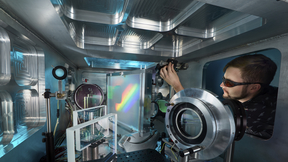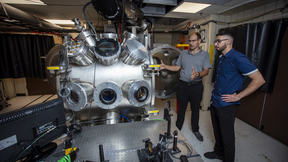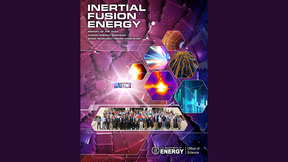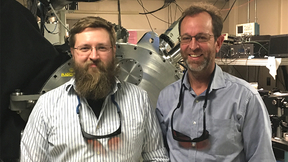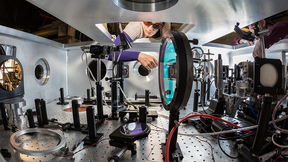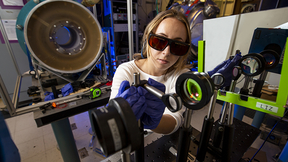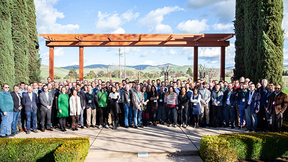Back
Jupiter Laser Facility
Big Ideas Lab podcast returns to shine a light on Jupiter Laser Facility
Since their invention in 1960, lasers have been a staple of science fiction. But beyond sci-fi, the technology is an essential, often overlooked, part of everyday life. From scanning barcodes to operating on eyes to recreating the conditions in the sun, laser applications range from mundane to life changing. The Jupiter Laser Facility (JLF) at Lawrence Livermore National…
A brighter future for the Jupiter Laser Facility
Since the 1970s, the Janus laser, now part of the Jupiter Laser Facility (JLF), has served as an experimental proving ground to Lawrence Livermore National Laboratory’s (LLNL) laser and fusion programs and the broader high-energy-density and laser science communities. Today, JLF is not only home to Janus — one of the world’s few hands-on laser platforms producing…
Prominence of LLNL Laser Science on Display at NIF-JLF User Groups Meeting
This year’s National Ignition Facility (NIF) and Jupiter Laser Facility (JLF) User Groups Meeting, held from February 11–13, highlighted the progress made to capitalize on and sustain NIF’s capabilities as well as the scientific advancements made in JLF’s first full year of operations following a major refurbishment.
LLNL selected to lead next-gen extreme ultraviolet lithography research
Decades of cutting-edge laser, optics and plasma physics research at Lawrence Livermore National Laboratory (LLNL) played a key role in the underlying science that the semiconductor industry uses to manufacture advanced microprocessors. These computer chips drive today’s astounding innovations in artificial intelligence, high-performance supercomputers and smart phones…
Félicie Albert elected vice chair of APS Division of Plasma Physics
Lawrence Livermore National Laboratory (LLNL) scientist and director of the Jupiter Laser Facility Félicie Albert has been elected to serve as vice chair of the American Physical Society (APS) Division of Plasma Physics (DDP) Executive Committee. Established in 1959, the objective of DPP is the advancement and dissemination of the knowledge, understanding, and applications…
Interns shine bright at the Jupiter Laser Facility
This summer, the Jupiter Laser Facility (JLF) hosted interns as part of the Reaching a New Science Energy Workforce (RENEW) program — a DOE Office of Science initiative aimed at developing a strong, diverse workforce pipeline through partnerships with minority serving institutions. The interns, Alexandra Koleva and Aliyah St Louis-Alleyne from Florida Agricultural and…
Two LLNL researchers named to Optica’s 2024 class of senior members
Lawrence Livermore National Laboratory (LLNL) researchers Paul Armstrong and Brent Stuart have been named senior members of Optica. The professional society’s senior membership status recognizes members with more than 10 years of professional experience in optics or an optics-related field. The 2024 class joins a distinguished group of scientists, engineers, entrepreneurs…
The drive to break a swimming record
Five-time Olympic trials competitor Brandon Fischer knows how to persevere. As one of the oldest competitors in this year’s Olympic trials, the Lawrence Livermore Natonal Laboratory mechanical technologist at the Jupiter Laser Facility broke the 35-39 Masters World Record in the 100-meter and 200-meter breaststroke events. Fischer’s first foray into the water was in the …
Finding Livermore: Employees share their LLNL origin stories
With more than 70 years of history and nearly 9,000 current employees, it is not uncommon for several generations of family members to have worked at Lawrence Livermore National Laboratory (LLNL). For those employees with parents or grandparents preceding them, a career at the Laboratory was not in their original plans. In fact, before coming to LLNL, many do not realize…
Jupiter Laser Facility gets a reboot
Fifty years ago, the first laser, Janus, was installed in Building 174 (renamed the Jupiter Laser Facility in 2006) at Lawrence Livermore National Laboratory. Additional lasers, more than 100 Ph.D.s granted time on the system and thousands of international users later, the Jupiter Laser Facility (JLF) celebrated its grand reopening Thursday after a four-year refurbishment,…
LLNL’s Jupiter Laser Facility funding renewed for additional research in discovery science
The Department of Energy’s Office of Science recently announced $28.5 million for LaserNetUS to advance discovery science and inertial fusion energy. Lawrence Livermore National Laboratory (LLNL) is one of nine facilities operating high-intensity, ultrafast lasers that will receive additional funding. LaserNetUS is North America's high intensity laser research network…
A passion for physics drives Danny Attiyah
This summer, Danny Attiyah, a third-year Ph.D. student at the University of California, Irvine, will develop theory, create simulations and put those simulations to the test in a long experimental run. “I’m excited to go from theory to experimental results during my internship,” he said. Attiyah, who grew up in Southern California, was drawn to math as a student. But when…
NIF and JLF user groups look beyond ignition to bright possibilities in science
Attendees at this year’s National Ignition Facility (NIF) and Jupiter Laser Facility (JLF) User Groups Meeting celebrated Lawrence Livermore National Laboratory's (LLNL) recent fusion ignition breakthrough at the National Ignition Facility, but also kept their focus on looking ahead to a bright future of high energy density (HED) science research. The forward-thinking…
Ignition gives U.S. ‘unique opportunity’ to lead world’s IFE research
Lawrence Livermore National Laboratory (LLNL)’s historic achievement of fusion ignition Dec. 5 at the National Ignition Facility (NIF) positions the United States with a “unique opportunity” to further lead the world scientific community’s pursuit of developing fusion as a future source of clean energy, according to a newly released report. Capitalizing on that opportunity…
Scientists put additive manufactured foams to the test
Lawrence Livermore National Laboratory (LLNL) scientists recently published the results of a three-week experimental campaign at the Lab’s Jupiter Laser Facility to test the performance of laser-heated additive manufactured foams. The project helps support two major Laboratory focus areas, including helping to advance additive manufacturing and by enabling improvements in…
DOE awards $18 million to LaserNetUS consortium
LaserNetUS, a network of facilities operating ultra-powerful lasers including those at Lawrence Livermore National Laboratory (LLNL), has received $18 million from the Department of Energy (DOE) for user support. Established in 2018 by DOE, LaserNetUS is organized and funded by DOE’s Office of Fusion Energy Sciences (FES). The new network was created to provide vastly…
NIF-JLF User Group 2020 Meeting
At the recent 2020 NIF and Jupiter Laser Facility (JLF) User Group meeting, we ask attendees to tell us why the annual conference is important for their work and for the exciting future of high energy density science.
Summer scholar reels in ‘STRIPED FISH’ for NIF
In high school, Liz Grace thought physics was boring and instead considered studying psychology or music. But then a college professor inspired Grace to see the wonders of physics. Today, as a National Ignition Facility (NIF) & Photon Science Summer Scholar, she’s helping to design and build a diagnostic instrument that could become a revolutionary measurement tool for…
NIF and Jupiter Laser Facility user groups meet to discuss recent experiments, new capabilities
The annual National Ignition Facility (NIF) and Jupiter Laser Facility (JLF) User Group meeting brought together more than 180 researchers to learn about the capabilities, recent experiments and new experimental platforms of both Lawrence Livermore National Laboratory (LLNL) facilities. The attendees included 61 students and represented 31 institutions across six countries…
DOE looks to Jupiter for high-intensity research
The Department of Energy deemed Lawrence Livermore National Laboratory (LLNL) as one of nine facilities operating high-intensity, ultrafast lasers. DOE’s Office of Fusion Energy Sciences (FES) within the Office of Science awarded the new research network, called LaserNetUS, $6.8 million over the next two years. LaserNetUS includes the most powerful lasers in the United…












